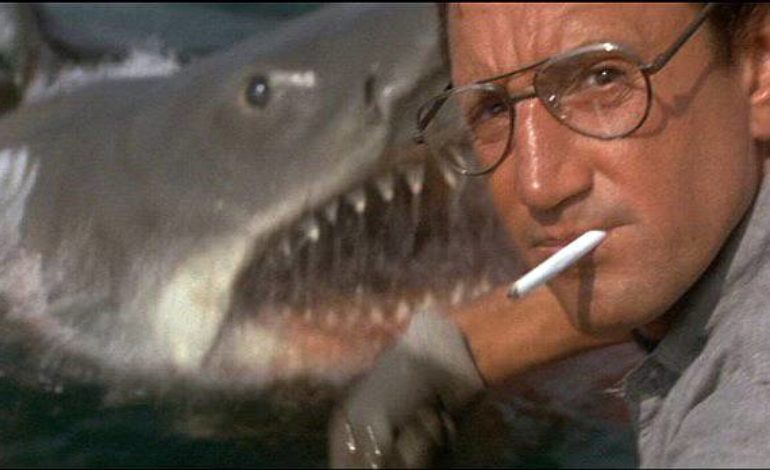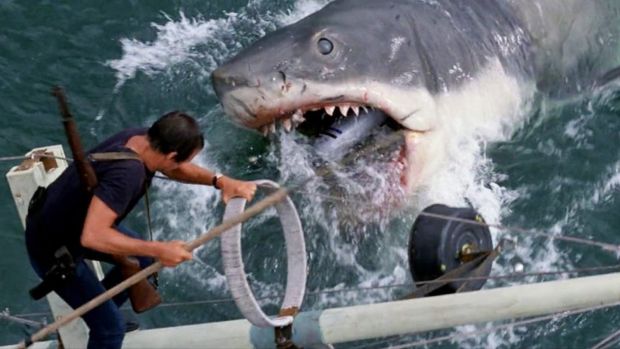

The great white shark might just be the most feared animal on the planet. With rows of razor sharp teeth, powerful speed, and a potential to reach up to 20 feet in length, it’s not hard to see why. Of course, your odds of being attacked by a great white, or any shark for that matter, are incredibly miniscule. Despite this, a fear of sharks has shaken a number of people enough to make them seriously question getting back into the water at all, and this fear can be traced back to the release of Steven Spielberg’s breakout hit Jaws.
The story for Jaws is based on the novel by Peter Benchley which in turn took inspiration from real life shark attacks, but the film pushed it into the spotlight. Noteworthy not just for really kick starting Spielberg’s career, but also creating the whole idea of a summer blockbuster. Spielberg managed to craft a brilliant thriller that focused less on cheap jump scares, and instead relied on dread, mood, and tension to tell a suspenseful story. The film has received much praise and analysis for its restrained use of showing the shark, but also important were the key ways Spielberg took a real animal and turned it into one of the most iconic cinematic monsters. However, what also must be addressed is the negative, real world impact this film left on shark populations.
Benchley’s book was inspired by the real life Jersey Shore shark attacks of 1916, in which four people were killed in a series of shark attacks all within close proximity. This was one of the first major instances of a wide spread hysteria surrounding shark attacks. Both the book and the movie feature a great white attacking people, but funnily enough many scientists now agree that the 1916 attacks were carried out by the smaller but more aggressive bull shark. Of course, when Spielberg was developing the film, it only made sense to go with what would create the most suspense; the larger and more well-known great white.


Right away it’s important to realize that the shark of Jaws, nicknamed Bruce by the production crew, has very little in common with a real world great white. For one, the creature in the film is fair bit larger than a great white. While the shark in the film is never given an exact size, the eagle eyed Quint identifies it to be about twenty-five feet in length. The average adult great white can be anywhere from eleven to sixteen feet long, with females being larger and the largest ever recorded being slightly below twenty feet. The shark’s increase in size is an easy way to make it more threatening and also further separates it from the real, creating less an animal and more a monster.
The shark in Jaws is also a full blown man-eater. While sharks have been known to attack and prey on people, the chances of being attacked are astronomically low. Great white sharks are indeed one of the few species to have caused fatalities, but humans are almost never on the menu. Most shark attacks are the result of mistaken identity or the shark being provoked in some way. A shark that not only intentionally attacks people but also eats them is practically unheard of. A shark would only prey on humans in a complete absence of food or as the result of a freak occurrence. The shark’s intentional targeting of the boat is also especially aberrant shark behavior and showcases a malice just not found in actual animals. It puts “Bruce” more in line with Michael Myers then it does an actual shark.
The important way to view Jaws is through the lens of a monster movie. Bruce is a shark in name and appearance only. To take the film as an accurate depiction of sharks is erroneous. Though not many would claim Spielberg was trying to create a nuanced, accurate take on marine life. He set out to make a thriller and he succeeded with an incredibly gripping story that has endured over the years. What cannot be understated is the long term ramifications the film had on actual shark populations. In 1975, in midst of the release of the film, beach attendance was down from previous years. More significantly thousands of sharks were killed in the wake of the film. Many species of sharks were already endangered and great whites especially were hurt by the amount of killings done be humans. Peter Benchley even went on record saying if he knew the book and film would result in all the shark killings, he wouldn’t have written it.


Perhaps more egregiously was that even documentaries began to adopt Jaws’ fearmongering. Discovery Channel’s Shark Week used to have a strong focus on educational programming before shifting to sensationalized programming focusing primarily on great white shark attacks. While Jaws resulted in harm to shark populations, it was at least designed to be a monster movie. However when educational programming begins adopting the techniques of drama, it begins to have even more disastrous impacts on the real world.
Jaws funnily enough becomes one of the best examples of art impacting to reality. To say “it’s just a movie”, diminishes the fact that Jaws did seriously impact the way people engage with the natural world. It’s a shining example of the way that audiences latch on to and are intrigued by monsters. The shark of Jaws has become so engrained in pop culture that it has actually eclipsed the thing it’s based on. The conversation has evolved and people have begun to become more and more understanding of sharks, but it’s important to always refer back to what Jaws did and make sure not to repeat those mistakes.
